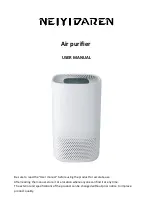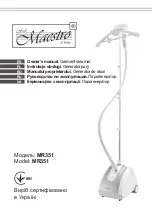
that the two vertical lines of the plug and the socket respectively
match and lock by twisting the plug clockwise.
Check (by pulling apart) if the plug is locked correctly.
•
Connect handle of the suction hose to the tube with with steam hose,
fit together the plug-in connectors of the steam hose. Ensure that the
two vertical lines of the plug-in connections match and lock by
twisting. Check if locked correctly.
•
Fitting the accessories
Put floor tool or wall and windows nozzle on the end of the tube with
with steam hose and fit together with the plug-in connections of the
steam hose as decribed above.
•
The wall and window tool may, the steam jet nozzle with crevice tool
must be put onto the handle directly.
•
Ensure that all switches are off.
•
Unroll the mains cable to ist full length and plug it in.
3.5 Putting the machine into operation
•
Switch on the red main switch (B4); lights up when switched on.
•
Switch on the yellow switch for the heating (B6); lights up when
heating is running.
•
Wait until the yellow heat check lamp (B6) switches off. Now the
machine is ready for operation.
•
Switch on steam exhaust by pressing the switch (G1) on the handle.
•
The green check lamp (B5) lights up. By pressing the switch again,
the steam turns off.
•
Switch on the vacuum motor by pressing the switch (G2) on the
handle. By pressing the switch again, the vacuum motor switches off.
3.6 Working method
•
Cleaning with steam jet nozzle and crevice tool
The steam jet nozzle is used to clean difficult-to-reach areas. By
means of the steam jet, dirt in edges, crevices, interstices and gaps
is removed as follows:
- press switch (G1) on handle for steam exhaust.
- remove dirt with steam jet.
- vacuum solved dirt with the crevice tool.
Note
Prespray heavily soiled spots directly with adequate cleaning agent.
Caution
The steam temperature at the exhaust of the nozzle is approx.100°C.
When cleaning heat-sensitive materials do not remain under a minimal
distance of 2-5!
•
Cleaning with the floor tool
Pre-spray a deep cleaner or floor cleaner directly on heavily soiled
spots with an adequate hand spraying bottle and let the agents a few
minutes to take effect.
First remove the dirt with steam from the floor tool. Move the tool
forwards and backwards with a slight pressure on the handle. The
vacuum dirt and water with switched-on vacuum motor.
For daily cleaning, steaming and vacuuming in on step are sufficient.
Note that when moving the floor tool forwards, the dirt is removed,
and when moving it backwards, the dirt is vacuumed.
Caution
Do not clean heat-sensitive floors and materials!
•
Cleaning with the wall and window tool
For the cleaning of glass and tiles, use the wall and window tool as
follows:
- Press the switches for the steam valve (G1) and for the vacuum
motor (G2).
- Place the tool on the top of the area to be cleaned and pull it
downwards. When pulling it downwards, stop the steam supply
shortly before reaching the end of the strip to prevent steam from
exhausting innecessarily.
- The wall and window tool is to be placed flat on the area to be
cleaned to prevent condensed water from running down.
- Where necessary, the tube with with steam hose can be used as
an extension.
Caution
In the cold season the windows are to be preheated. Heat the window
with the wall and window tool from a distance of approx. 10cm.
3.7 Lack of water during the operation
•
The red low-water check lamp (B3) blinks when the fresh water
tank/boiler is empty. The heating is switched-off automatically.
Procedure:
- Switch-off the yellow switch (B6) for heating.
- Keep on working an use up the rest of the steam.
- Switch-off red main switch (B4).
- Unplug the machine from the mains.
- Slowly unscrew the security cover from the clean water filling hole
and let the rest of the steam escape.
- Refill with tap water (10-60°) and fit security cover tightly. Put
machine into operation as described in chapter 3.5.
Caution
Never open the security cover of the fresh water filing opening as
long as the machine is under steam pressure. Danger of
scalding!!!
4. Maintenance
4.1. Safety instructions
When cleaning and servicing the machine or changing parts, pull
the mains connector plug.
The machine must not be cleaned with high pressure steam
cleaners or powerful liquid jets.
For reparations use only original spare parts.
Important:
Before commencing any maintenance work, switch of the
machine and unplug it from the mains.
5. Corrective
maintenance
We recommend that repairs and inspections are carried out by an
authorised service agent.
Emptying waste water
After using the machine, completely drain the waste water tank and
rinse thoroughly with clean water.
Procedure:
- Push the ball on the discharge hose to the side and let the waste
water drain into a bucket or a floor drain.
- Tightly close the ball again.
Emptying the fresh water
After finishing work, frain the fresh water. When the machine has
cooled off, open the drain screw (D1) at the bottom of the machine with
a tool, let water and lime residues frain. Close the drain screw tightly.
Decalcifying the fresh water tank/boiler
Depending to the water hardness, decalcify the fresh water tank/boiler
from time to time with a decalcifier. After decalcifying rinse thouroughly
with clean water. The machine must never be heated when
decalcifying.
5.1 Fault-finding and rectification
Weak vacuum power:
•
Suction pipe, suction hose or nozzle obstructed?
•
Waste water tank cover on the waste water tank not correctly
positioned (secondary air)?
•
Filter of suction pipe in the waste water tank cover obstructed?
•
Ball of drain hose not properly closed?
Insufficient steam generation
•
Heating switch off?
•
Heating check lamp still alight, working temperature not yet reached?
The vacuum motor of the DS 7 is provided with a thermal overload
switch, which shuts-off the motor automatically if it overheats.
6. Storage
If the machine is not being used, it is to be cooled and stored dry and
under normal room conditions (not under 0°C).
7. Disposal
Disposal of packaging must take place acccording to national
regulations.





























